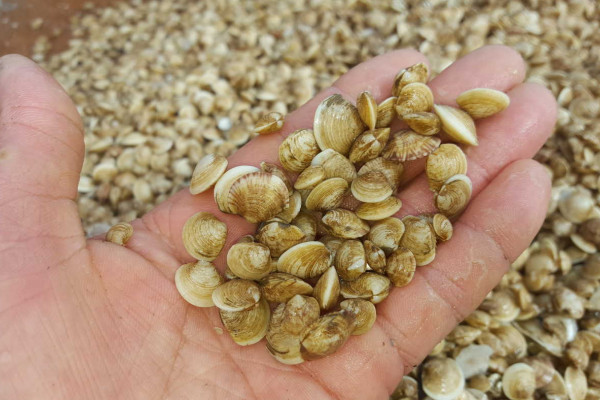
ARC is almost 60 years old and was a pioneer in the shellfish industry
By Lisa Cavanaugh
If you have enjoyed local shellfish, chances are your meal started as a seed from the Aquacultural Research Corporation.
The ARC hatchery, located in Dennis on a beautiful spit of land on Cape Cod Bay at the mouth of Chase Garden Creek, provides approximately 80 percent of the seed for shellfish propagation on Cape Cod, and spawns millions of oysters and quahogs every year.
It is the only hatchery on the Cape.
Founded in 1960 by Van Alan Clark, Jr and his brothers, who were heirs to the Avon Cosmetics fortune, ARC was a pioneer in the shellfish industry.
“Van Alan was a visionary in aquaculture,” says Gail Hart, former vice president and treasurer of ARC. “He was very interested in all things oceanographic and he had the idea of opening a hatchery here, at a time when there was no one else growing seed on Cape Cod.”
For the first two decades, the company produced and grew hard shell clam seed from the larval stage to plant for themselves, but by the early 1980s the ARC team began to sell seed, both quahogs and oysters, to shellfish farmers on the Cape. Traditionally, shellfishermen would seed their grants from wild spat, but as the local commercial aquaculture industry began to grow, using ARC seed proved more reliable.
By the 1990s, the Clark family interest in the business was waning. When Van Alan died his brothers became eager to sell, but they didn’t want to see ARC come to an end. They sold the business to several of their longstanding employees, Dick Kraus, Sue Machie, and Hart.
“We ran that place for 20 years,” Hart recalls. “Dick oversaw everything, with a focus on the hatchery and the field. Sue was in charge of the algae operation, and I ran the warehouse, national sales, and the administration end of things.”
All three had started at ARC in the 1970s; by 2015 they realized it was time to reassess their ability to stay committed day to day. “A hatchery is intensive and expensive to operate,” says Hart. “We invested and rehabbed and ran it for two decades, we kept it going, kept our hardworking staff employed, even through a red tide year when we thought it would put us under.”
The hatchery buildings needed substantial renovation, and the hatchery’s crucial support for the aquaculture industry needed to be maintained. And so a unique public-private partnership coalesced:
Kraus, Machie and Hart sold most of their company’s coastal property, 30 acres, to the Town of Dennis, supported by funding from the Dennis Conservation Trust, The Nature Conservancy, Barnstable County, the Commonwealth of Massachusetts and the towns of Dennis and Yarmouth. Ten additional acres where the hatchery sits were placed into a permanent conservation restriction that allows shellfish propagation and education, but no other development.
Then a group of private investors bought the business, another unique collection including the Cape Cod Commercial Fishermen’s Alliance, Wellfleet Shellfish Promotion and Tasting (SPAT), and a handful of private inves-tors. Rob Doane, formerly of the Wellfleet Shellfish Company, was brought in as CEO and President.
“The people and organizations who wanted to invest did so because of the social impact,” says Hart. “None of us wanted the land to be turned over to developers. Shellfishing is such an economic engine for Cape Cod and we wanted ARC to continue to be a leader in the industry.”
John Pappalardo, CEO of the Fishermen’s Alliance agrees. “ARC supports more than 1,400 jobs in commercial shellfishing and the seafood industry,” he said. “There are also about 17,000 recreational shellfish licenses sold each year on Cape Cod. ARC seed helps make that all happen. Shellfishing is such an enormous part of our past and of our future success. The Fishermen’s Alliance felt we could not allow the hatchery to close.”
And so the work continues.
There are two levels of production at ARC. The hatchery grows seed in heated water, to mimic conditions in the summer months when shellfish naturally feed and breed. “Broodstock” oysters and clams produce eggs and sperm. Once the eggs are fertilized they are moved to culture tanks, where the larvae remain from between two weeks to 20 days, depending on species, feeding on the algae that ARC produces on site.
Next the seed is transferred to downwellers, where water from Chase Garden Creek is pumped in. To continue growing the shellfish, ARC also takes advantage of the naturally occurring algae in Nantucket Sound and sends seed to upwellers on that body of water, including two new ones in Chatham and Harwich set to open this spring.
When the shellfish reach 5-20 millimeters, they can be shipped to customers, primarily in New England.
ARC also has grants in Barnstable and Wellfleet, where they grow their own product to market size and sell shellfish across the country and to Canada. “We don’t sell our mature shellfish on Cape Cod,” says Hart. “It was a strategy to protect our seed buyers, giving more market power to the local farmers. We aim for the big wholesale national markets looking for sustainable, high-quality shellfish.”
In addition, ARC supplies “spat on shell” for oyster reef building across Cape Cod. These restoration programs can rid waterways of excess nitrogen, over-abundant algae and other dangerous pollutants.
Looking back over 50 years, CEO Rob Doane appreciates ARC’s unique history and continuing role. “The innovation that came before is a torch I want to continue to carry,” he says. “We work to apply ongoing technologies to aquaculture so we can continue to provide the best shellfish seed possible.”
